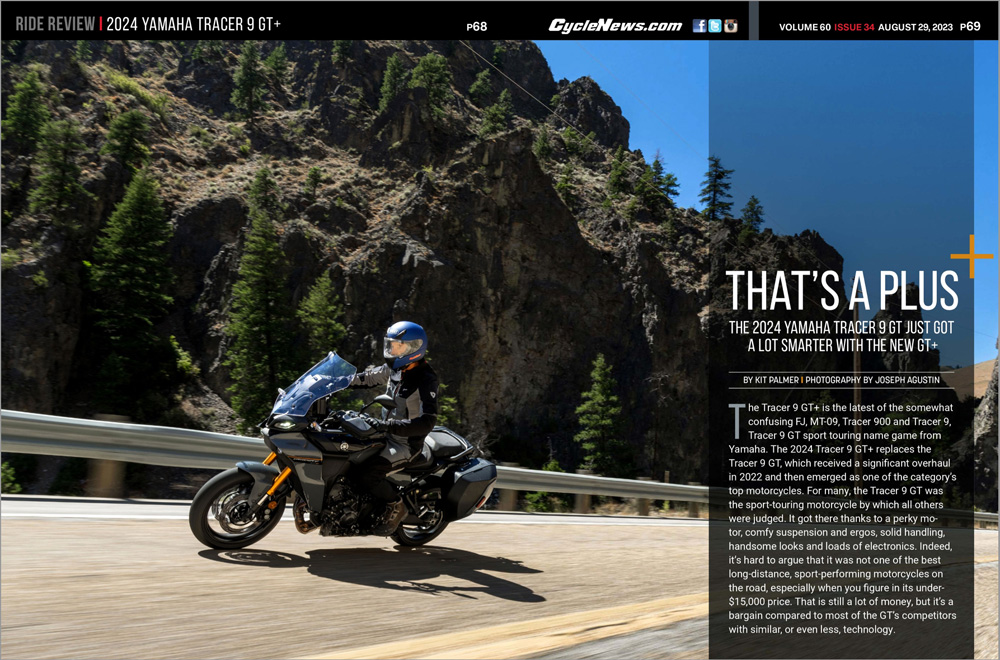Kit Palmer | September 1, 2023
The 2024 Yamaha Tracer 9 GT just got a lot smarter with the new GT+
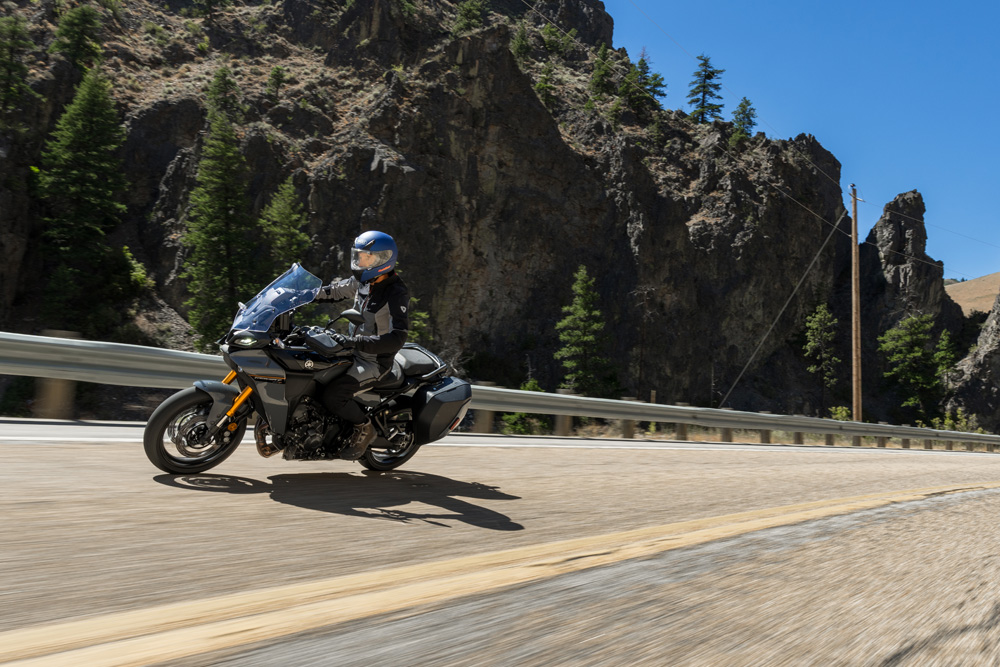 The 2024 Yamaha Tracer 9 GT+ features mostly upgraded electronics, including radar.
The 2024 Yamaha Tracer 9 GT+ features mostly upgraded electronics, including radar.
Photography by Joseph Agustin
The Tracer 9 GT+ is the latest of the somewhat confusing FJ, MT-09, Tracer 900 and Tracer 9, Tracer 9 GT sport touring name game from Yamaha. The 2024 Tracer 9 GT+ replaces the Tracer 9 GT, which received a significant overhaul in 2022 and then emerged as one of the category’s top motorcycles. For many, the Tracer 9 GT was the sport-touring motorcycle by which all others were judged. It got there thanks to a perky motor, comfy suspension and ergos, solid handling, handsome looks and loads of electronics. Indeed, it’s hard to argue that it was not one of the best long-distance, sport-performing motorcycles on the road, especially when you figure in its under-$15,000 price. That is still a lot of money, but it’s a bargain compared to most of the GT’s competitors with similar, or even less, technology.
Yamaha says it wasn’t looking to replace the GT by making the GT+ faster or sportier but to instead bump up the GT’s “level of capability and comfort significantly.” And how did Yamaha attempt to do that? By upgrading the GT’s electronics suite, so much so that Yamaha gave it a new name.
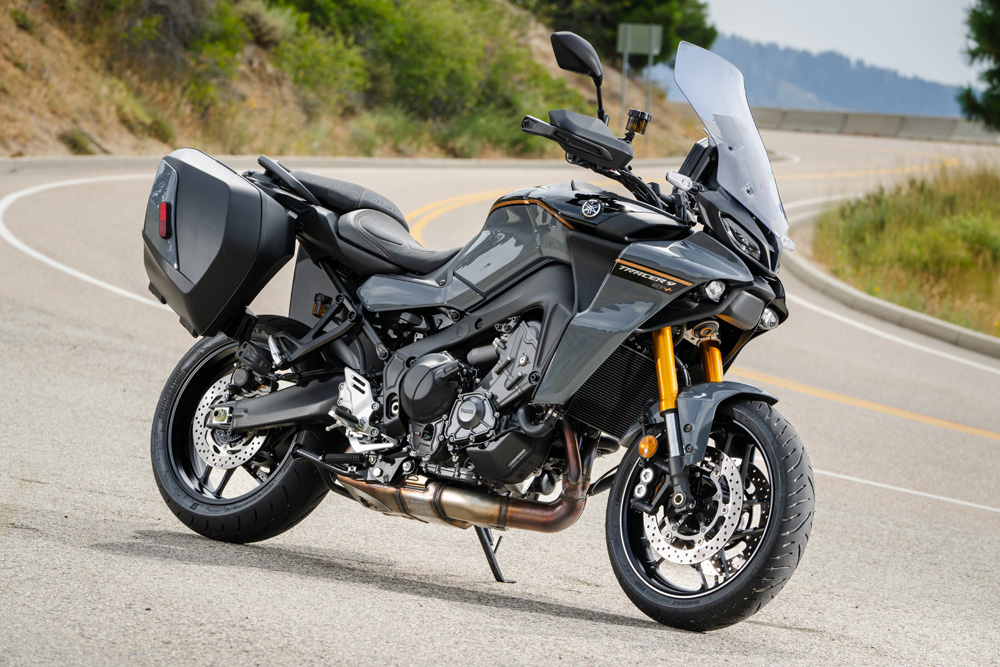 The 2024 Yamaha Tracer 9 GT+ features mostly upgraded electronics, including radar.
The 2024 Yamaha Tracer 9 GT+ features mostly upgraded electronics, including radar.
2024 Yamaha Tracer 9 GT+ Review | Plus, What?
What is the difference between the GT and GT+? Just from the looks of things, not much. It carries over the same 890cc CP3 Transverse inline-triple engine, cast aluminum frame and semi-active suspension as the previous model. Bodywork hasn’t changed, nor have the panniers. Instead, the GT+ is all about technology and its heavily upgraded electronics suite. The previous GT was already loaded with electronics; now it has even more, and what it already had has been refined.
But the biggest news is the new Adaptive Cruise Control (ACC) and radar-linked Unified Brake System (UBS), a first for Yamaha. ACC automatically controls cruising speed, deceleration and acceleration to match the vehicle’s speed in front of you to maintain a constant following distance based on four adjustable presets. ACC couldn’t happen without Yamaha’s new Millimeter Wave Radar (MWR) unit, housed inconspicuously in the GT’s nose between its two small headlights.
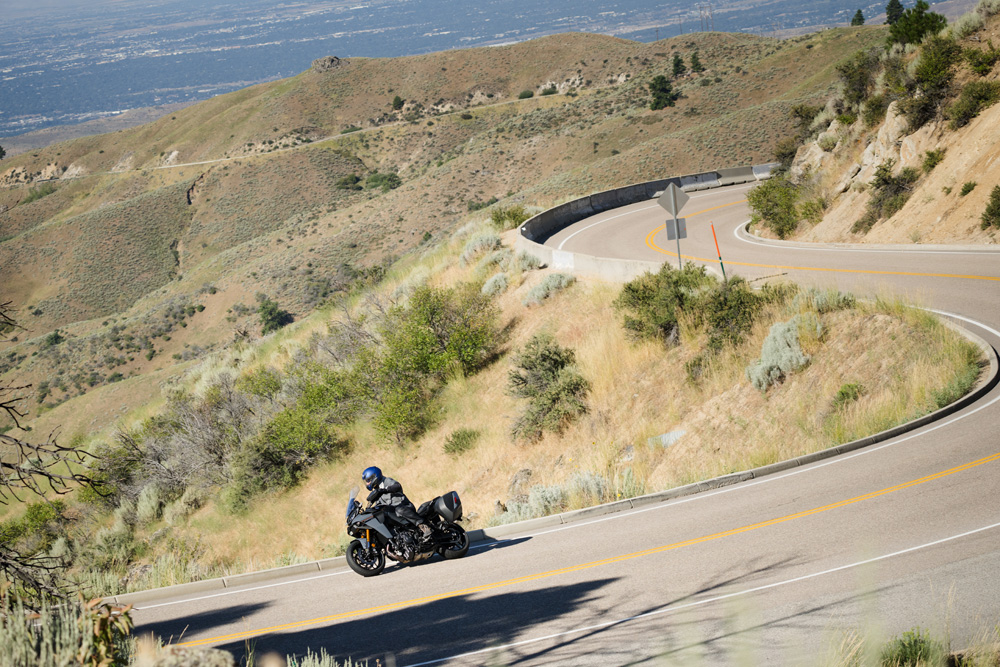 The GT+ is comfortable, feels light and agile, and is unintimidating, which are all great qualities for long and twisty days in the saddle.
The GT+ is comfortable, feels light and agile, and is unintimidating, which are all great qualities for long and twisty days in the saddle.
The GT utilizes data from the MWR and its six-axis Inertial Measurement Unit (IMU) to assist your braking input when the distance to the vehicle in front closes to a certain level while simultaneously adjusting front/rear braking bias and front/rear suspension damping force. If a car ahead is determined to be too close for the given brake pressure, the system assists by adding more braking force. Yamaha has given us four following distances to choose from—a minimum of one second and a maximum of two seconds. The system will only provide braking assistance when the Brake Control (BC) feature is turned on and the rider is already braking—Yamaha makes it clear that it is not a collision-avoidance system, and it won’t stomp on the brakes for you should you be looking in the wrong direction at the wrong time. The system isn’t designed to prevent collisions, so you must stay engaged while riding the motorcycle. When BC is on, the system also monitors the cornering brake control.
The radar-linked UBS also works independently of the cruise control. When BC is turned on and you suddenly apply the brakes because of an object in the road, the radar unit will inform the brake’s hydraulic unit if additional braking force can be applied.
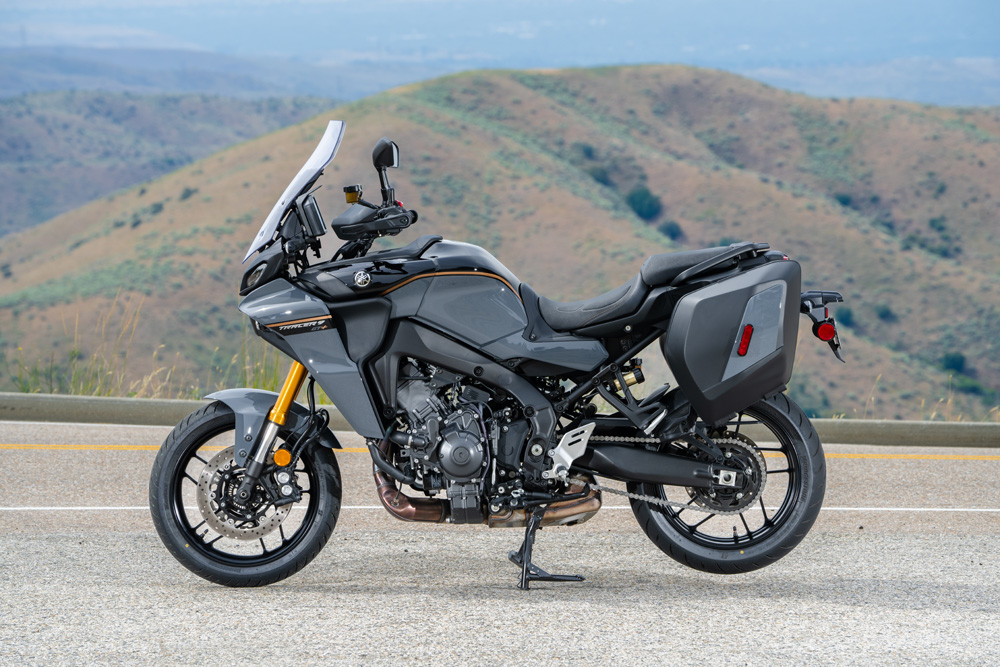 Price went up, but you still get a lot for the GT+’s $16,499 asking price.
Price went up, but you still get a lot for the GT+’s $16,499 asking price.
Yamaha also beefed up the mechanicals of the GT+’s rear brake. The disc diameter has grown from 245mm to 267mm, and, to improve feel, there is a new beveled brake pedal.
The GT+’s updated six-axis IMU still provides data to the ECU to enable the Traction Control System (TCS), Slide Control System (SCS) and the front-wheel LIFt control system (LIF). Each of the systems can also be turned on or off, and the TCS, SCS and LIF can have their levels of intervention adjusted to your preference.
The GT+ is fitted with the latest-generation KYB Actimatic Damper System (KADS) electronically controlled suspension but with updated settings. There are two suspension modes—A-1 for sport (smooth surfaces) and A-2 for comfort (bumpy surfaces). And that’s not all; KADS will make further minute adjustments as you lean the bike in the corners.
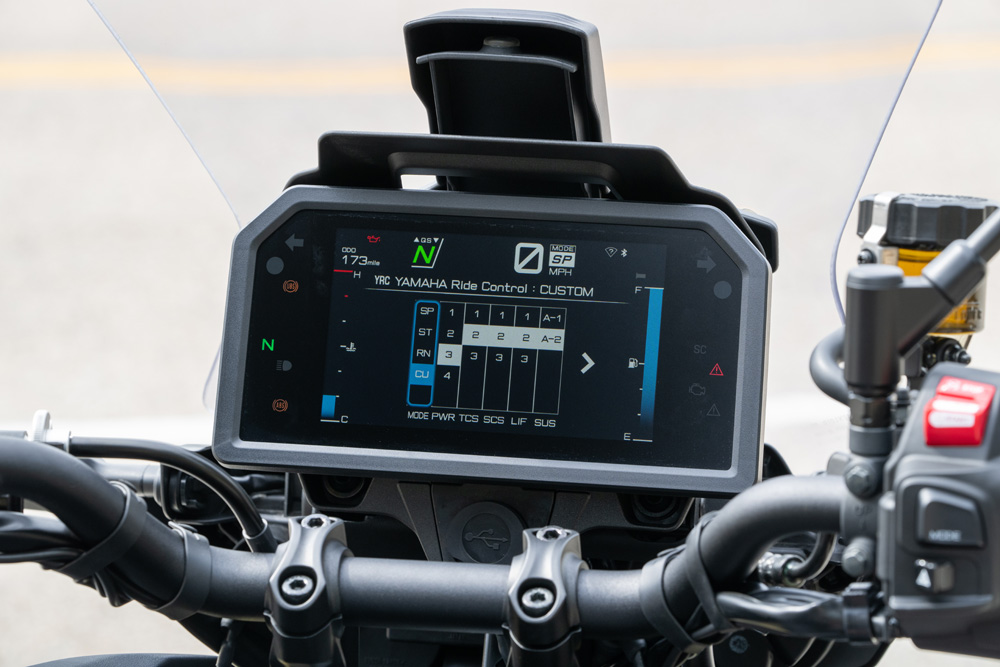 The new seven-inch full-color TFT dash is now one-piece, full of information and easy to read.
The new seven-inch full-color TFT dash is now one-piece, full of information and easy to read.
You have four riding modes from which to choose: Rain, Street, Sport and Custom. In Custom mode, you select the levels of engine power, traction control, slide control, lift control and suspension (hard or soft). The mode button is positioned on the right switchgear, which is now backlit.
Besides the new Storm Gray paint, what sets the old GT apart from the new GT+ visually is its cockpit display. The former two-piece robot face-looking display has been replaced by a single, seven-inch color TFT display that is easier to read and more informative. It’s also capable of linking to smartphones and Bluetooth accessories, and it accepts Yamaha’s MyRide-Link app that will display text messages and incoming calls on the TFT meter and provides other useful touring information like weather. You can also access full-screen turn-by-turn navigation on the TFT display after downloading the Garmin Motorize app, which requires a subscription fee. A USB-A outlet is also provided just below the meter.
Any function that has to do with the new TFT display is now operated by a joystick on the left handlebar switchgear. The joystick replaces the love-it-or-hate-it control wheel.
The GT+ quickshifter has also been updated to work in conjunction with the Adaptive Cruise Control. It allows you to change gears without disengaging cruise control. You can also now downshift under acceleration and upshift under deceleration.
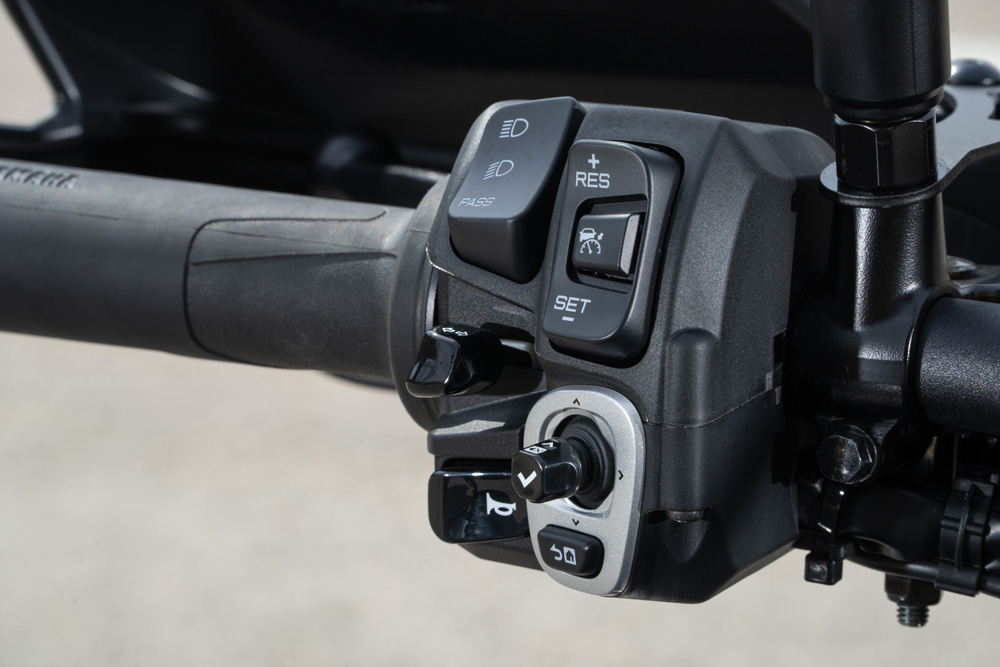 A joystick replaces the love-it-or-hate-it control wheel.
A joystick replaces the love-it-or-hate-it control wheel.
You will pay a little more for all this new technology—$1600 more. You also get a new seat cover that has updated padding and is grippier. You also get seven more pounds, but the GT+ still weighs just under 500 pounds.
The GT+ retains many comfort-minded elements that previous GT owners loved about the bike, like heated grips, hand guards, and an adjustable windscreen. It also retains cornering lights, adjustable footpegs, a height-adjustable seat, a five-gallon fuel tank, Bridgestone T32 Battlax tires and all-around LED lighting.
2024 Yamaha Tracer 9 GT+ Review | Time To Go
Performance-wise, nothing has really changed. The GT+’s motor is as punchy as it was, and the initial throttle response at low rpm is still notchy-free. It has tons of torque, accelerates smoothly and is plenty fast, just like the previous GT. Nothing about this engine is violent, but it indeed goes when goosed. And it sounds sooo good doing so!
Everything that is mostly new about the GT+ is staring you in the face. The new dash is a 100-percent improvement. It looks much nicer and works better; you can quickly decipher almost anything you need to know instantly, even in bright sunshine, due to an anti-glare coating. And it’s a bonus that you can easily change things up a bit with the three different face options, even though they are not radically different. It didn’t take long to figure out how things work and what buttons to press. Very intuitive. You never have to delve too deep to find what you are looking for.
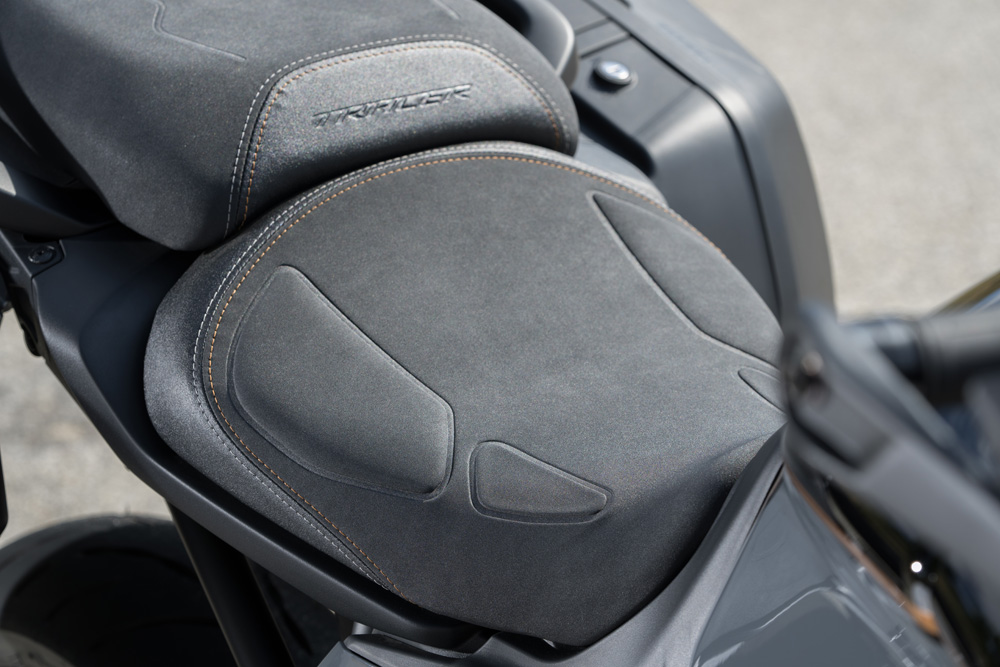 There’s less sliding around with the new seat cover and it has more padding.
There’s less sliding around with the new seat cover and it has more padding.
Hopping on the GT+, I was most anxious to try the adaptive cruise control, but unfortunately time wasn’t on our side. Yamaha invited the press to Boise, Idaho, for a quick one-day ride to get our first taste of the bike, but the wonderful twisty mountain roads in a rather large group of motorcycles being ridden at a spirited pace isn’t a great environment for testing cruise control. That will come another day; we already have a long-term test lined up with the GT+. However, we do have experience with adaptive cruise control on other motorcycles, and the technology is very cool, so we’re anxious to give Yamaha’s system a thorough test in the following weeks.
I did, however, get to play with almost everything related to GT+’s new electronics, like the three fixed (preset) integrated ride modes that combine engine, rider aids and suspension all in one. Yamaha says this was done to simplify things for the rider while making adjustments on the fly. In Sport mode, you get the spiciest power setting combined with the least amount of TCS, SCS and LIF intervention with the stiffest (A-1) suspension settings. In Street mode, you get slightly less engine spice, a bit more intervention, and the softer (A-2) of the two suspension choices. In Rain mode, you get the mellowest of everything. Custom mode lets you choose the level of power and interventions and suspension settings (A-1 or A-2) you want. You can’t adjust suspension damping independently with the GT+, but you can tweak preload (manually).
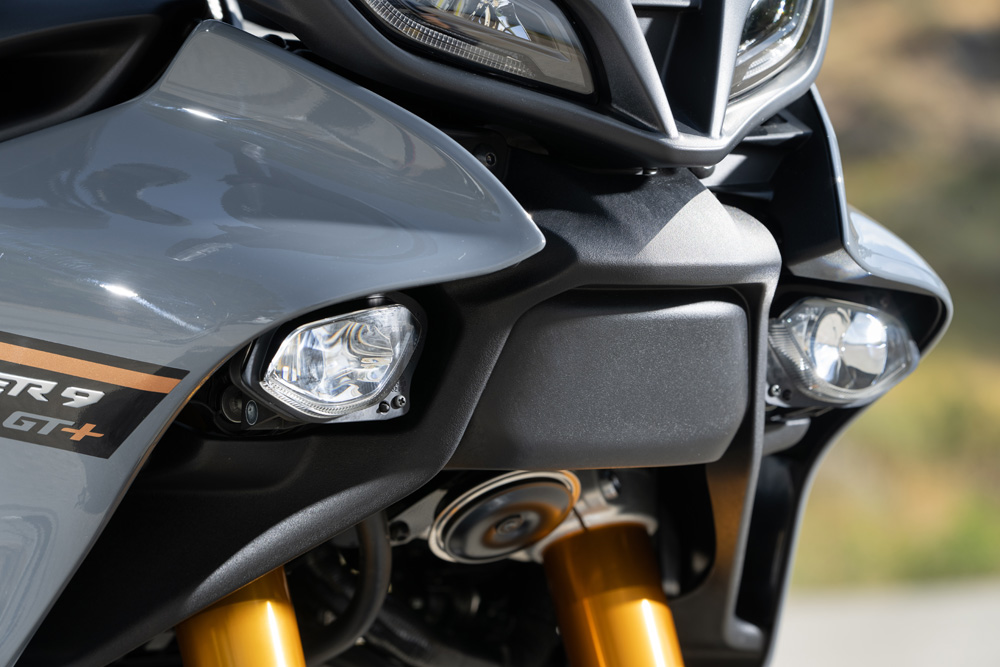 You can see the GT+’s Millimeter Wave Radar unit in the bike’s nose between the two headlights.
You can see the GT+’s Millimeter Wave Radar unit in the bike’s nose between the two headlights.
The differences between the three preset ride modes are immediately noticeable when it comes to at least the power and suspension. I bounced back and forth a lot between the Sport and Street modes and thought Street was a good, comfortable all-around, all-day choice for casual/feisty backroads touring. I liked that the GT+ remembers your settings after you turn off the engine.
You can also tell the difference between the A-1 and A-2 suspension modes. A-1 is noticeably stiffer but still comfortable; however, I preferred the softer A-2 setting for my 170 pounds.
I found the seat and its new cover to be very comfortable. It has slightly more padding built in strategic areas, and the grippier material keeps you from sliding around, especially forward. My 6’1” frame preferred the taller of the two seat height options (32.9 inches versus 32.3 inches).
Being able to adjust the windscreen while in motion is terrific, but I would like to see more range. Technically, it has 10 positions, but in reality, it’s just two—full up or full down.
The odd-shaped panniers look large but are only 30L in capacity and won’t quite fit a full-face helmet. The latches are simple to use, though. Want more storage? Yamaha offers 34L and 45L top cases for the GT+ as accessories.
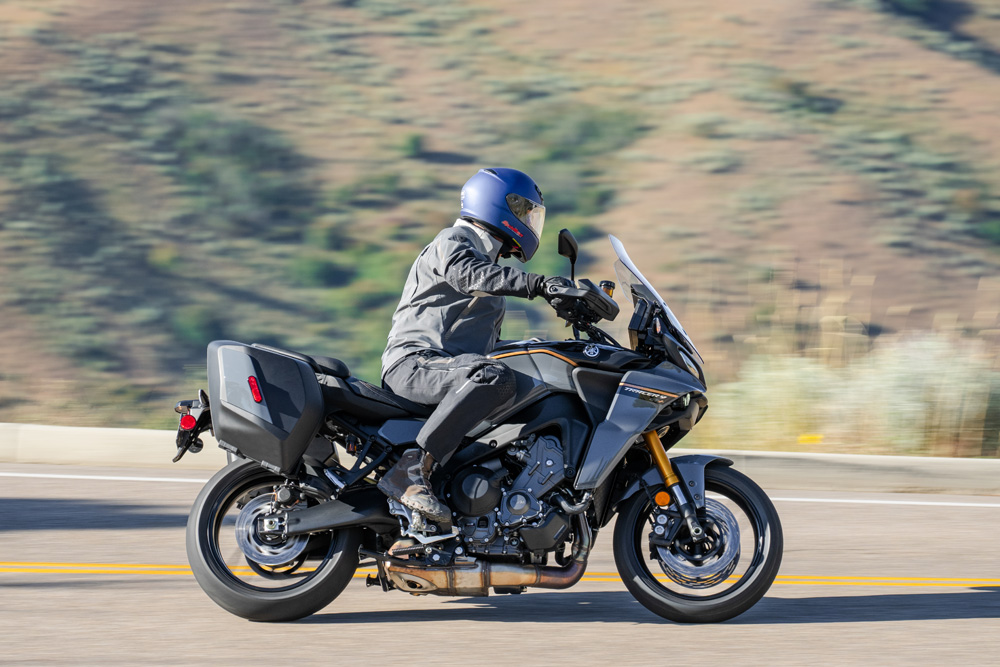 The GT+ offers a good mix of sport and comfort.
The GT+ offers a good mix of sport and comfort.
2024 Yamaha Tracer 9 GT+ Review | Day Over
You can’t properly review a motorcycle like the Yamaha Tracer 9 GT+ in just a day, but it only takes a few hours to know that the GT+ is an outstanding sport-touring machine jam-packed with the latest technology. When it gets down to the meat and potatoes, though, the GT+ is still a motorcycle and an excellent-performing motorcycle at that. It does its intended job well. You might think with all the electronics and rider aids that the GT+ has to offer, that it might take away from some of the basic riding experiences and thrills of riding a motorcycle that we all enjoy, but not so on this bike. All those sensors and gyros are doing their thing in the background, and you don’t even know it.
When Yamaha said it wanted to significantly bump up the GT+’s level of capability and comfort, all we can say for now is mission accomplished. CN
VIDEO | Yamaha Tracer 9 GT+ Review
Yamaha Tracer
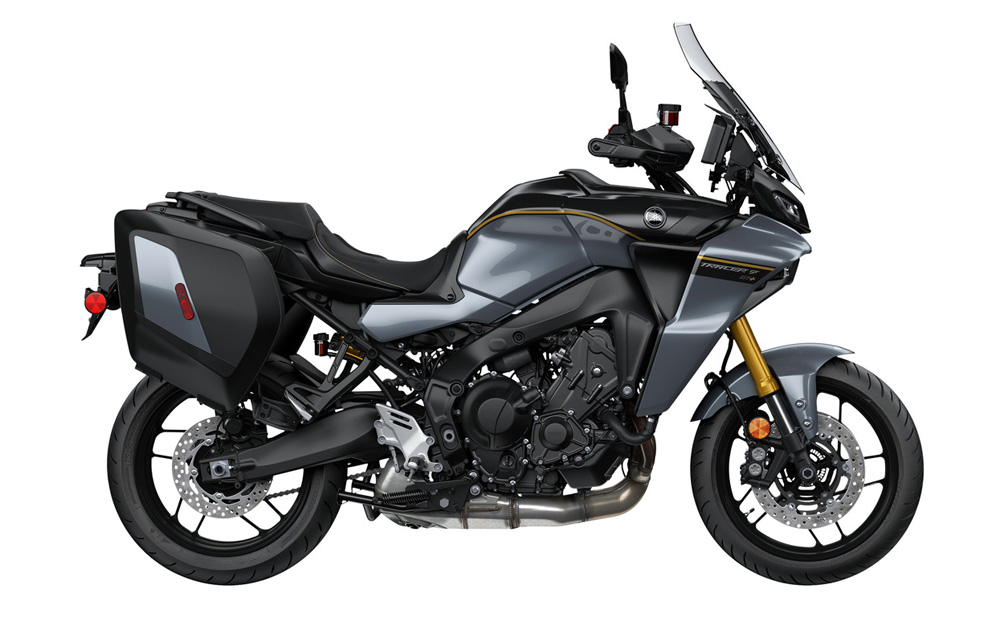
2024 Yamaha Tracer 9 GT+ Specifications
| MSRP: |
$16,499 |
| Engine: |
Transverse inline triple |
| Valvetrain: |
DOHC w/4 valves per cylinder |
| Displacement: |
890cc |
| Bore x Stroke: |
78.0 x 62.1mm |
| Compression Ratio: |
11.5:1 |
| Valve Insp. Interval: |
26,600 miles |
| Fuel Delivery: |
EFI w/ YCC-T & 41mm throttle bodies x 3 |
| Lubrication System: |
Wet sump |
| Cooling System: |
Liquid |
| Horsepower (claimed): |
108 at 10,000 rpm |
| Torque (claimed): |
63 lb-ft at 7,200 rpm |
| Transmission |
6-speed, cable-actuated wet slip/assist clutch & up/down quickshifter |
| Final Drive: |
O-ring chain |
| Frame: |
Cast aluminum w/ engine as stressed member, cast aluminum swingarm & steel subframe |
| Wheelbase: |
59.1 in. |
| Rake/Trail: |
25 degrees/4.3 in. |
| Seat Height: |
32.3/32.9 in. |
| Front Suspension: |
41mm inverted fork, electronically adj. rebound & compression, manually adj. preload |
| Rear Suspension |
Single shock, electronically adj. rebound, manually adj. preload (remote) |
| Front-Wheel Travel: |
5.1 in. |
| Rear-Wheel Travel: |
5.4 in. |
| Front Brake: |
Dual 298mm discs w/ 4-piston radial calipers, ABS |
| Rear Brake: |
Single 267mm disc w/ 2-piston caliper, ABS |
| Front Wheel: |
Cast, 3.50 x 17 in. |
| Rear Wheel: |
Cast, 5.50 x 17 in. |
| Front Tire: |
120/70-ZR17 in. |
| Rear Tire: |
180/55-ZR17 in. |
| Wet Weight: |
492 lbs. |
| Load Capacity: |
407 lbs. |
| GVWR: |
910 lbs. |
| Fuel Capacity: |
5.0 gal. |
| Fuel Consumption: |
45.9 mpg |
| Estimated Range: |
230 miles |
| Warranty: |
1-year, unlimited miles |
